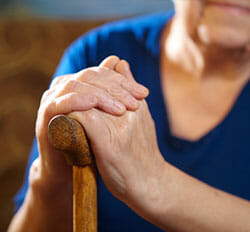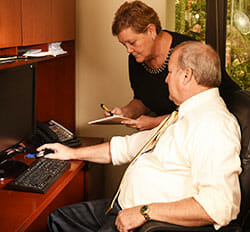Fall Liability in Long Term Care Facilities
View Article as PDF
Falls are extremely common among older persons. It is estimated that 30% of non-institutionalized persons over the age of 65 fall every year, and this rate increases with age. Falls in long term care settings are even higher. Various studies indicate that at least half of the residents in nursing homes and assisted living facilities fall at least once a year. And those who do fall often have multiple falls. Falls are the major cause of accidental death for people over age 75. Although most falls do not result in death, many falls can lead to sequelae impairing physical functioning and quality of life. Loss of function may be a physical anatomical loss and/or a psychological loss caused by lack of confidence or fear of falling. Head, hip and spinal fractures are the most debilitating.
Establishing Liability
Establishing liability in nursing home and assisted living cases follows the same general negligence or malpractice principles as other type personal injury cases. A duty or standard of care must be established. Then a breach of the duty or standard of care must occur which proximately caused the injury. And, as in any case, damages resulting from the injury must be shown. The issue of damages in long term care cases is beyond the limited scope of this article.
As a result of the high risk of falls in the elderly, especially in settings such as nursing homes and assisted living facilities, the facilities should develop policies, practices and procedures for fall risk assessment, care plans and interventions to prevent injuries.
A Complete Fall Assessment
In nursing home settings, there are statutory requirements by both Federal and State law. Under Federal Law (OBRA), a Residential Assessment Instrument (RAI) is required initially and periodically to assess residents entering a skilled nursing facility that receives payments from Medicare or Medicaid. The RAI process is based on the following steps:
- Assessment. Taking stock of all observations, information and knowledge about a resident; understanding the resident’s limitations and strengths; finding out who the resident is
- Decision-Making. Determining the severity, functional impact, and scope of a resident’s problems; understanding the causes of and relationships between a resident’s problems; discovering the “what’s” and “whys” of resident problems
- Care Planning. Establishing a course of action that moves a resident toward a specific goal using individual resident strengths and interdisciplinary expertise; crafting the “how” of resident care
- Implementation. Putting the course of action (specific interventions on the care plan) into motion by staff knowledgeable about the resident care goals and approaches; carrying out the “how” and “when” of resident care.
- Evaluation. Critically reviewing care plans goals; interventions and implementation in terms of achieved resident outcomes and assessing the need to modify the care plan( i.e., change interventions) based on changes in the resident’s status, either improvement or decline.
The assessment is done initially and periodically on a form known as the Minimum Data Set (MDS). This form is used for many statistical and clinical purposes. It consists of a comprehensive assessment of a resident’s physical, cognitive, social, behavioral, ability to be independent, wounds and a variety of other functional data. This form is completed by multiple disciplines including nurses, therapists, social workers and others. Although there is no specific part that deals specifically with falls, if various risk factors and events occur or are likely to occur, it “triggers” an additional assessment known as a Resident Assessment Protocol (RAP). Many States have developed their own guidelines for fall risk assessment once a RAP is triggered. The RAP for falls provides a systematic approach to the evaluation of a fall and assessment guidelines to assist staff in identifying common fall risk factors and developing care plan interventions.
The Center for Medicare Services’ (CMS’) RAP form lists the following as risk of initial falls or potential for additional falls:
- Fell in past 30 days
- Fell in past 31-180 days
- Wandering
- Dizziness
- Use of Trunk Restraint
- Use of Anti-anxiety Drugs
- Use of Anti-depressant Drugs
Risk Factors for Falls & Injury
Further examination into the possible risks of falls must be made by evaluating the internal risk factors and external risk factors.
Internal risk factors include:
- Cardiovascular
- Neuromuscular (loss of arm and leg movement, decline in functional status, Incontinence, hypotension, CVA, hemiplegia/hemiparesis, Parkinson’s, seizure disorder, syncope, unsteady gait and other acute and chronic conditions)
- Orthopedic (joint pain, arthritis, fracture of hip, missing limb, osteoporosis)
- Perceptual (impaired hearing, impaired vision, dizziness/ vertigo
- Psychiatric or Cognitive (delirium, decline in cognitive skills, manic depression, Alzheimer’s, other dementia)
External Risk factors include:
- Medications (psychotropic, cardiovascular and diuretics)
- Appliances/ Devices (pacemaker, prosthetics, cane/walkers/crutch, restraints)
- Environmental/Situational Hazards and Circumstances of Recent Falls (glare, illumination, slippery floors, uneven surfaces, carpets, foreign objects, lack of handrails, new arrangement of objects, recent move-in, proximity to aggressive resident, time of day, time since meal, type of activity, standing still/walking, reaching, bladder/bowel urgency)
 Once the internal and external risk factors are determined, an individualized plan needs to be devised for each resident. This may also involve the resident’s physician, especially if there are medications. The American Geriatric Society has developed Guidelines for the Prevention of Falls in Older Persons. The guidelines as well as information obtained on the MDS, RAP and information from the family and other health care providers should provide enough data to develop a care plan that reduces the risk of falls or serious personal injury. Many facilities have developed their own checklist or scoring tools for fall risk potential. Obviously, the higher the risk, the more aggressive the care plan and interventions should be. Interventions may include changes in medication, footwear, physical therapy, gait training, walking assistance devices, bed alarms, lowering a bed, safety mats near a bed and hip protectors.
Once the internal and external risk factors are determined, an individualized plan needs to be devised for each resident. This may also involve the resident’s physician, especially if there are medications. The American Geriatric Society has developed Guidelines for the Prevention of Falls in Older Persons. The guidelines as well as information obtained on the MDS, RAP and information from the family and other health care providers should provide enough data to develop a care plan that reduces the risk of falls or serious personal injury. Many facilities have developed their own checklist or scoring tools for fall risk potential. Obviously, the higher the risk, the more aggressive the care plan and interventions should be. Interventions may include changes in medication, footwear, physical therapy, gait training, walking assistance devices, bed alarms, lowering a bed, safety mats near a bed and hip protectors.
Once there is a change in the resident’s medical condition or status, they would need to be re-assessed and revisions of the fall prevention plan would need to be made.
Regulation Violations by Long Term Care Facilities
Additional general violations of OBRA are often cited by attorneys to show negligence and by state surveyors to support deficiencies. Some examples in fall cases include:
42 CFR § 483.25(a) — Based on a comprehensive assessment of the resident, the facility must ensure that —
- A resident’s abilities in activities of daily living do not diminish unless circumstances of the individual’s clinical condition demonstrate that diminution was unavoidable. This includes the resident’s ability to—
- Bathe, dress and groom;
- Transfer and ambulate;
- Toilet;
- Eat; and
- Use speech, language or other functional communication systems.
- A resident is given the appropriate treatment and services to maintain or improve his or her abilities specified in paragraph (a)(1) of this section; and,
42 CFR § 483.25(h)(1-2) — The facility shall provide each resident a safe and secure environment, with adequate supervision and assistive devices so as to prevent accidents.
42 CFR § 483.13(c) — The facility shall not neglect a resident.
42CFR § 483.10(b)(10) — The resident’s physician shall be notified immediately, and the resident’s responsible party promptly, whenever there is an accident/incident involving the resident which requires potential medical intervention.
42 CFR § 483.30 — The nursing needs of the resident shall be met 24 hours a day, 7 days a week; and, there shall be sufficient staffing to enable the resident to attain or maintain her highest practicable physical well-being. Also, see the federal Interpretive Guidelines.
Related Article: Understaffing & Safety Concerns
42 CFR § 483.20 — Care plans shall address the comprehensive needs of the resident. Care plans shall be followed. Care plans shall be revised quarterly as resident needs dictate. Also, see the federal Interpretive Guidelines.
42 CFR § 483.13(c) — All injuries of unknown origin to a resident shall be reported to state authorities.
42 CFR § 483.40 — Physician orders shall be followed.
42 CFR § 483.75(1) — The facility shall ensure that the resident’s medical records be consistent with professional standards. Nursing progress notes shall be sufficient and identify the resident clearly, describe the resident’s condition fully and justify treatment and the results of said treatment.
42 CFR § 483.25 — Each resident shall receive, and the facility shall provide, care and services to enable the resident to attain or maintain the highest practicable physical, mental and psychosocial well-being, in accordance with the individual’s assessments and care plan.
42 CFR § 483.15 — Each resident shall be treated with dignity.
42 CFR § 483.75 — Facility staff shall be knowledgeable in caring for the aged, frail and disabled. Staff shall be properly trained in accident prevention.
42 CFR § 482.13(c) — Each resident shall be free of abuse and neglect.
42 CFR § 483.13(c)(1)(i) — The facility must develop and implement written policies and procedures that prohibit mistreatment, neglect, and abuse of residents and misappropriation of resident property.
What Inspectors Look For
In Maryland, The Office of Health Care Quality has included the following items for the annual surveyor’s inspection of a nursing home regarding falls:
- Facility has a fall reduction program that includes the following:
- Resident assessment for risk
- Environmental assessments
- Risk reduction strategies
- In-service education
- Resident/Family education program
- Development of transfer protocols
- Staff education of transfer protocols
- Environmental redesign
- Restraint assessment/reduction
- Facility conducts comprehensive investigation for injury
- Facility has mechanism to review falls
- Facility has policy to refer fallers to PT
- Facility has osteoporosis education program
- Facility has osteoporosis screening program
- Facility has osteoporosis treatment program
- Facility has criteria for monitoring accidents and injuries
- Facility does not have high prevalence of falls
- Facility has method for environmental assessment to deter time and place for accidents and injuries
- Facility has established time frame for referral to QA Committee for accidents and injuries
- Facility has plan for f/u for accidents and injuries
Assisted Living Facilities & Regulations
Assisted Living Facilities (ALFs) are not regulated federally. Each state has the authority to adopt regulations regarding the licensing and care in the facilities. Maryland has adopted regulations; however the forms for risk assessments are not the same as the MDS, RAP, etc. in the nursing home context. Instead, the State of Maryland requires a Preadmission Assessment. This assessment requires a comprehensive determination of the resident’s health problems, medical history, and other factors in determining the level of function in activities of daily living (ADL) and care required. Based on the Preadmission Assessment, a Service Plan for each resident “shall be developed in a manner that enhances the principles of dignity, privacy, resident choice, resident capabilities, individuality, and independence without compromising the health or reasonable safety of other residents.” This Service Plan must be done within 30 days of admission and then reviewed and updated every 6 months. A Resident Record or Log must be maintained for each ALF resident. This record must, at a minimum, contain the preadmission assessment, medication orders, rehabilitation plan, service plan, care notes and emergency data. Numerous other services are required of ALFs including mobility, transfer, ambulation and assistance with other ADLs. When an incident or accident occurs, reporting is required under the Maryland statute. An “incident” includes a fall requiring medical treatment.
Since by definition ALFs are lower level care institutions and encourage independence of their residents, especially with mobility, cases are often more difficult to litigate. However, many of the risk, assessment, planning and intervention issues are the same as nursing homes. Larger ALFs have developed their own screening tools.
Unfortunately there is usually less skilled nursing care at ALFs, so often residents’ conditions and required levels of care change and poor planning occurs to prevent falls.
In Maryland there are three levels of care in ALFs – Level One being the most independent and Level Three the most dependent on staff in assistance with ADLs. Often a resident should really be in a nursing facility instead of an ALF, because the ALF staff could not meet a resident needs.
A review of the complete resident chart is vital to determining the merits of a case. In addition to the MDS, RAP and Care Plans, careful attention to the other documentation should be made. Often a health care worker notes a problem, but no one does any follow-up. Common documents include:
- Records from health providers prior to admission
- Physician Orders
- Fall Risk Assessment Worksheets
- Medication records and flow sheets
- Physical Therapy notes
- Occupational Therapy notes
- Social Worker notes
- Nursing notes
- Outside consultants
- Transfer and discharge summaries into the facility
- Admission records from another facility
Determining the Cause of a Fall
While there are multiple events or factors which may cause a fall, a common defense tactic is to assert that the resident first suffered an unpredictable medical event that caused the fall. An example asserted in one of my cases was that the resident suffered a heart attack that caused her to fall. A careful review of the medical and nursing records along with expert testimony can often refute these assertions.
Establishing a breach of duty or standard of care requires expert testimony using both statutory and clinical means. Experts and state surveyors often refer to the violations in separately numbered “F tags”. The State Operation Manual, Appendix P and PP provide further statutory duties. When the State of Maryland conducts either a complaint survey or annual inspection survey of a nursing home, deficiencies are stated with reference to the F tags in lieu of citing the Code of Federal Regulations citation. Various publishers have attempted to put many of the statutory references together in one publication for practitioners.
Related Article: Who Can Be Held Liable?
Litigation Considerations
 Once a plaintiff’s attorney has made an initial determination that the claim has some merit, expert testimony by physicians, nurses, administrators, etc. will be needed to address the specific facts of each potential claim. Most falls do not warrant the high expense and amount of time to litigate these claims. The more difficult cases, and those which should be rejected by plaintiff’s counsel, are those with few risks factors, no history of previous falls and cases where the facilities did have some planning and interventions. Only those cases where trauma or fractures cause severe pain, injury, death, a change in the resident’s quality of life or cause other debilitating conditions should be pursued from a legal standpoint seeking compensation. The procedure for filing a claim in Maryland against a nursing home or assisted living facility is provided for in the Annotated Code, Courts and Judicial Proceeding Article 3-2A and 3-2C (Health Care Alternative Dispute Resolution). Failure to follow the strict statutory sections may result in dismissal of a claim for compensation. For cases where the expenses and damages may not warrant sufficient involvement by an attorney, the family should be instructed to file complaints with government agencies, so future care may be improved.
Once a plaintiff’s attorney has made an initial determination that the claim has some merit, expert testimony by physicians, nurses, administrators, etc. will be needed to address the specific facts of each potential claim. Most falls do not warrant the high expense and amount of time to litigate these claims. The more difficult cases, and those which should be rejected by plaintiff’s counsel, are those with few risks factors, no history of previous falls and cases where the facilities did have some planning and interventions. Only those cases where trauma or fractures cause severe pain, injury, death, a change in the resident’s quality of life or cause other debilitating conditions should be pursued from a legal standpoint seeking compensation. The procedure for filing a claim in Maryland against a nursing home or assisted living facility is provided for in the Annotated Code, Courts and Judicial Proceeding Article 3-2A and 3-2C (Health Care Alternative Dispute Resolution). Failure to follow the strict statutory sections may result in dismissal of a claim for compensation. For cases where the expenses and damages may not warrant sufficient involvement by an attorney, the family should be instructed to file complaints with government agencies, so future care may be improved.
In summary, by analyzing the specific facts of a resident’s case leading to severe injury and determining whether the proper assessments, care planning, implementation, documentation and statutory and clinical standards were met, a nursing home attorney should be able to weed out the cases which have merit and should be pursued.
View Articles as PDF
Related Article: Who Can Be Held Liable?


 Roger Weinberg is a skilled and experienced attorney who has pioneered the legal field of representing Nursing Home, Assisted Living, and Developmental Disability victims and their families who have experienced abuse, neglect and wrongful death. He is a leader in this field and teaches other lawyers, students and medical personnel about the laws impacting such cases. [
Roger Weinberg is a skilled and experienced attorney who has pioneered the legal field of representing Nursing Home, Assisted Living, and Developmental Disability victims and their families who have experienced abuse, neglect and wrongful death. He is a leader in this field and teaches other lawyers, students and medical personnel about the laws impacting such cases. [ 



